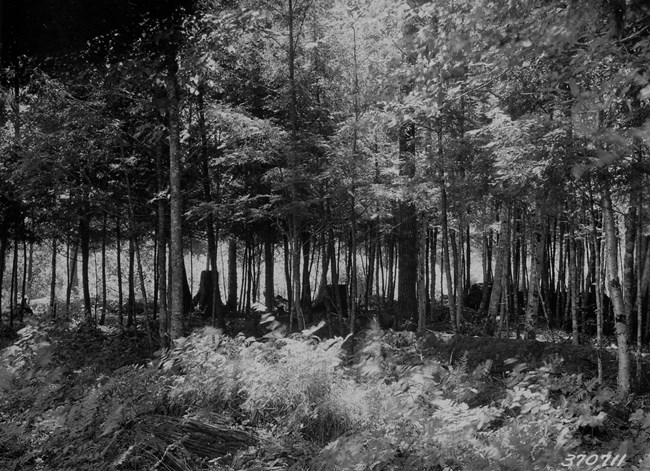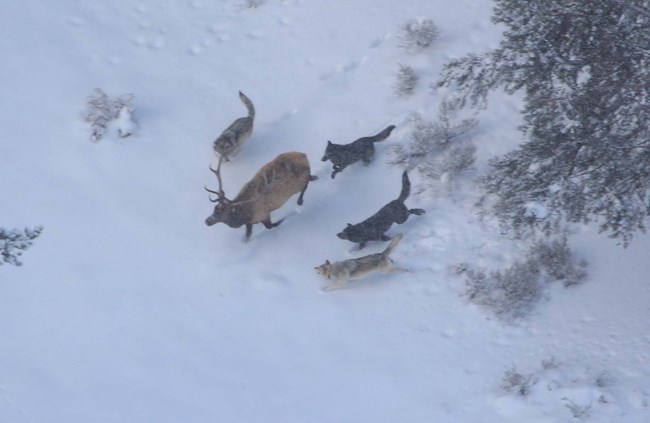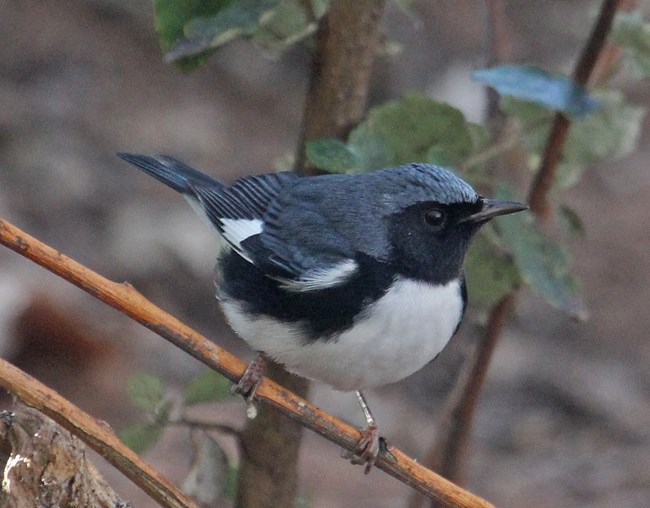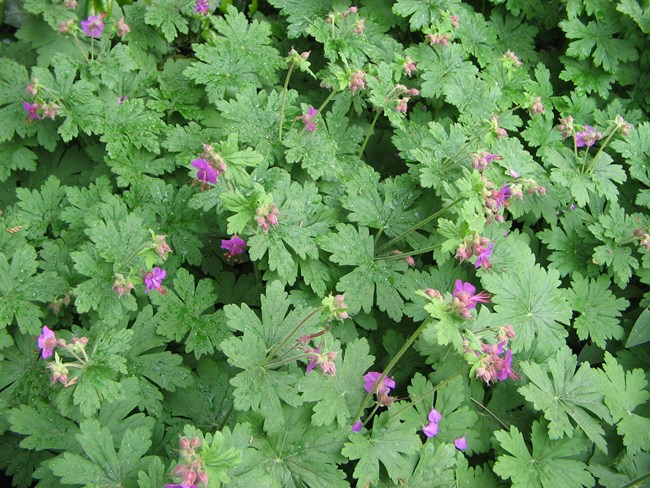When we try to pick out anything by itself, we find it hitched to everything else in the Universe. John Muir
Article
What’s the Buzz? How Bees Interrelate with Birds, Wildflowers, and Deer

USFS
John Muir was a master at observing the interconnectedness of nature. To the rest of us mere mortals, these connections are not always obvious. Such is the case for the relationship between birds, wildflowers, white-tailed deer, and our most important pollinator of both natural and agricultural plants - bees. Due to a combination of factors including a lack of “top-line” predators and the creation of abundant edge habitat by humans, Northeastern forest ecosystems, including several NPS I&M Northeast Temperate Network (NETN) parks, are becoming increasingly impacted by an over-abundant deer population. Stresses on area forests are only likely to intensify further due to climate change and the resulting phenological shifts which may throw off the synchronicity of native bee emergence with flowering times of wildflowers and plants.
Morristown National Historical Park was chosen to be part of a study looking at the relationship between white-tailed deer browsing habits, wildflower availability and emergence times, and insect pollinator populations - particularly bees. As generalist herbivores, deer preferentially feed on certain plants, trees, and shrubs which reduces the diversity and abundance of flowering plants. Damage can be so severe that many ecologists consider the over abundant deer population to be the single greatest threat to the long-term health of northeastern forests. In Morristown NHP, bee communities were surveyed in order to study potential “trophic cascades” (an ecological process that starts at or near the top of the food-chain and eventually makes its way to the bottom) of deer feeding habits on floral resources also used by bees.

Doug Smith/NPS
Studies of trophic cascades, where one or two keystone species greatly influences the ecology and behavior of dozens of other species, is relatively new to science. In the past it was thought that an ecosystem was built from the bottom up. Restoration projects often focused on the plant community with the belief that non-target species would also be restored once a critical mass of healthy plants had been established. Scientists believed that when this happened, insects, small mammals, birds, larger herbivores and finally the top predators fell neatly into a balance with each other. This may have been putting the cart before the horse, however, since some non-target species (such as insect pollinators) may actually be integral to the long-term success of plant restoration.
Wolves = More Fish
Perhaps the most famous example of a trophic cascade is what happened in Yellowstone National Park after the reintroduction of wolves in 1995. Before wolves were brought back into the mix, they had been absent from the Yellowstone ecosystem for almost 70 years. In that time, the numbers of deer and elk became artificially high and despite efforts by the park to control them, they reduced vegetation in some areas to almost zero (is this starting to sound familiar?). When wolves came back on the scene many interesting and sometimes unexpected things began to take place. To no one’s surprise, they began to hunt elk and deer but, more significantly, they also completely changed the behavior of these animals. Elk and deer herds started to avoid parts of the park where they could be most easily hunted by the wolves - particularly valleys and gorges. Almost immediately those places started to regenerate vegetation, with the height of some trees quintupling in just 6 years. What were once decades-long suffering over browsed, bare valleys soon became filled with saplings of aspen, willow and cottonwood trees. When this happened, many migratory bird species started moving in again. Beaver numbers and activity increased too, which in turn created niches for other species. The ponds they made provided habitat for otters, muskrats, ducks, fish, and amphibians. As berry-bearing shrubs recovered, grizzly bears had more fall forage to help them put on pounds and they started surviving winters in greater numbers. Perhaps most unexpectedly of all, the wolves also changed the way rivers moved through the park. With more streamside vegetation, erosion eased and rivers began to meander less. More pools formed, and more riffle sections were created - all of which are ideal fish and other wildlife habitat. Wolves indeed seem to be hitched to everything else in the Yellowstone ecosystem: Mr. Muir may have been on to something.

Jerry Oldenettel
Wolf reintroduction to Yellowstone has not been without controversy and other consequences of course. But it did inform science that in order to have a fully functioning, self-regulating trophic system in Yellowstone, a top-line predator needed to be re-added to the equation. Top-line predators such as wolves and mountain lions have been missing from the ecosystem of the eastern half of the country for well over a century in most places, and although eastern coyotes have begun to fill in that niche to a small degree, the deer population has exploded across much of the region. With deer putting extreme pressures on the floral resources available to pollinators, and bees in particular, there are concerns that these insects may be in decline. Human influences such as habitat destruction and climate change are only making the problem worse. Many insect species are dependent on only one or two varieties of host plants. The greater the variety of plant species, the greater the number of bee, butterfly and other insect species there are which can also influence the numbers and kinds of wildlife and bird species in the area.
Too Many Deer = Less Birds to Hear
In Northeastern forests, bees forage primarily in the early spring, visiting the first wildflowers in the understory. Competition from invasive plant species (which deer often avoid) and high levels of deer browsing in some forests have decimated understory wildflower diversity, but the impact of this loss on bee communities has yet to be quantified. Impacts on birds have been proven however, through data collected by the Vermont Center for Ecostudies and Cornell’s Lab of Ornithology, which showed over browsing by deer on understory vegetation can make it extremely difficult for shrub and ground-nesting birds such as Wood Thrushes, White-throated Sparrows, Hermit Thrushes, and Black-throated Blue Warblers to find suitable nesting sites. Deer browsing also impacts the quantity and quality of bee nesting availability. By selectively browsing on shrubs, deer may reduce potential cavity nesting sites for bees while simultaneously increasing the availability of bare ground and potentially benefiting below-ground nesting bees.

Réginald Hulhoven
Timing Can "Bee" Everything
The Morristown NHP study compared plant and pollinator communities within deer exclosures (fenced in areas that deer cannot access) and “control sites” outside of deer exclosures where the animals have free reign. Bee nest boxes were checked for colonization by cavity nesting bees such as mason and leaf-cutter bees. Cavity nesting bees are solitary (as opposed to the social honey bees) and use pre-existing holes or cavities to make their nests. These kinds of bees in particular are being studied in part because they emerge in early to mid-spring and are phenologically sensitive to temperature. In other words, they time their emergence based on how warm it is outside.
The study is also keeping track of the “phenological synchrony” between the bees and the flowers they rely upon to determine their sensitivity to climate variability. The nest boxes were monitored for species diversity and colonization rates, and the bees’ nests were studied to determine pollen usage. This information can be compared and contrasted with plant data collected by the NETN forest monitoring crew in the nearby forest study plots in order to determine how plant communities may influence nest site selection by cavity nesting bees. In 2012, three species of bees nested in the boxes, two of which were non-native. Not surprisingly, results have shown that plant communities within deer exclosures have a much higher abundance of insect pollinated plants than unprotected areas. By providing areas with a high diversity and abundance of native flowering plants, deer exclosures could help to support insect pollinator communities. For this same reason, many landscape designers, horticulturalists, and garden centers are increasingly recommending that homeowners landscape with native plants whenever possible, and to protect them from deer browsing. In the hardest hit places these small plots may be the last remaining refugia for many native insect populations.
Tags
- acadia national park
- appalachian national scenic trail
- boston harbor islands national recreation area
- eleanor roosevelt national historic site
- home of franklin d roosevelt national historic site
- marsh - billings - rockefeller national historical park
- minute man national historical park
- morristown national historical park
- saint-gaudens national historical park
- saratoga national historical park
- saugus iron works national historic site
- vanderbilt mansion national historic site
- weir farm national historical park
- yellowstone national park
- deer
- white-tailed deer
- bees
- pollinators
- wildflower
- wolves
- trophic cascade
- john muir
- species spotlight
- netn
Last updated: October 22, 2019
